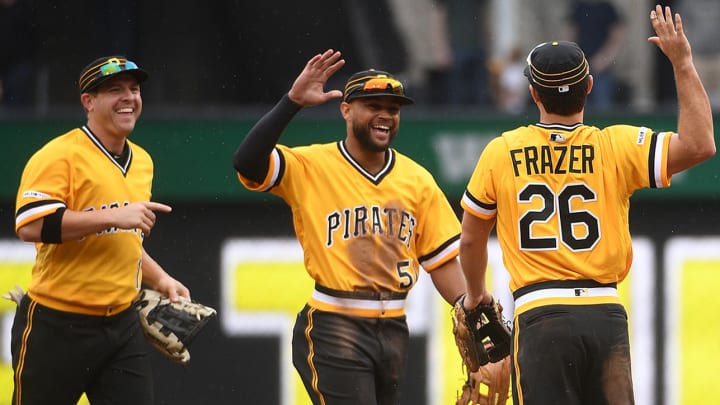The Pirates Are Thriving With a Vintage Style of Play

If you are wearying of Three True Outcome Baseball (more homers, walks and strikeouts with fewer balls in play) then you should be a fan of the Pittsburgh Pirates. Pittsburgh jumped out to a 12-7 start and first place in the NL Central by playing the kind of baseball that is disappearing: a strike-throwing pitching staff, rangy defense and an offense that never got the “Launch Angle” memo everybody else did.
“I like to manage a team that coaches can bring their kids to watch play,” Pirates manager Clint Hurdle said. “I definitely feel that way with this club. We’ve got a little throwback in us.”
Here is what the Pirates do best:
• Their pitchers throw more strikes than any other staff (65.9%) and have the lowest ERA in baseball (2.54).
• Their hitters have the lowest average launch angle in baseball (8.2 degrees) and the fewest strikeouts of any team in the National League–and also the fewest home runs.
• Their defense allows the lowest batting average on balls in play in the league (.256) and turns more batted balls into outs than any team in the league except the Dodgers.
• In 14 of their 19 games (including the past seven in a row) neither the Pirates nor their opponent scored more than five runs. Pittsburgh is 9-4 in those 1968-style, tightly-contested games.
It’s an athletic, crisp style of baseball in a game that otherwise keeps narrowing in variety. It’s early, sure, but so far in MLB this year strikeouts are up for a 14th straight year, walks are at their highest rate in 19 years and the home run rate exceeds the all-time high set in 2017. Games average 16 full-count pitches, up from 13 just four years ago.
But when you watch a Pirates game, the ball is in play. Players are in motion. The game is competitive. The Pirates have the fewest Three True Outcomes in the league.
Pittsburgh may well turn out to be this year’s version of the 2018 Mariners, who were bound to crash after winning a crazy number of close games. Its margin of error is extremely thin. But keep this in mind: Pittsburgh has 12 players on the injured list, including its entire starting outfield. This team has help on the way. It should contend at least for a wild card, and with the collection of arms they run out to the mound, extended slumps are difficult to foresee.
“When you’ve got a starting rotation like we’ve got,” Hurdle said, “you can use your bullpen when you want to, not when you have to.”

Jameson Taillon, Chris Archer, Trevor Williams, Joe Musgrove and Jordan Lyles all are righthanded pitchers who attack the strike zone. Taillon has a 2.77 ERA since May 27, 2018, when after fiddling in a bullpen sessions with a slider, broke out 30 sliders that night. The pitch has become his favorite since.
Archer always had a nasty slider, Williams has a freakish four-seam fastball that over the past two seasons is the fourth toughest to hit from any starter (behind only Gerrit Cole, Jacob deGrom and Max Scherzer; min. 300 results), Musgrove is throwing more of his filthy sliders and Lyles is breaking off more curves.
There’s a pattern here with Taillon, Archer, Musgrove and Lyles: the Pirates, a team under pitching coach Ray Searage that worshipped the almighty sinker, has changed with the rest of baseball and embraced a heavier dose of breaking pitches. Look at the drastic change in approach:
Pirates' Breaking Ball Use
| Percentage | MLB Rank |
|---|---|---|
2019 | 32.4% | 6 |
2018 | 25.0% | 22 |
2017 | 23.2% | 26 |
2016 | 21.5% | 28 |
2015 | 24.6% | 15 |
Last Friday night, shortstop Erik Gonzalez, a gifted defender, crashed into centerfielder Starling Marte, who has five seasons with more than 20 steals but none with more than 20 homers. Both wound up on the injured list. At 1 a.m. the Pirates summoned Cole Tucker, 22, and Bryan Reynolds, 24, to make their major league debuts. Neither one has much power, but both are tall, rangy, athletic players.
In his third big league at-bat Saturday, in a 1-1 game with San Francisco, and working without any sleep, Tucker had to step out of the batter’s box because of a flash of lightning beyond the outfield. He stepped back in and, Wonderboy style, smashed the next pitch to dead center for a two-run homer, his first hit in the bigs. A few minutes later, the heavens opened up and play stopped for good. Pittsburgh won, 3-1.
Tucker, 22, is the breath of fresh air the game needs. He grew up in Arizona, the son of a former minor league ballplayer (“Jackie,” Tucker said of his dad, “like Jackie Robinson”) and a former track and volleyball athlete at Arizona (Erin). He wanted nothing more than to be a big leaguer from such a young age that he learned how to read by reading the Arizona Diamondbacks media guide. He is an unabashed fan of baseball at a time when some players think it’s cool to say, “I don’t watch games.”

He is a baseball glove nerd who uses an oddly big one to play shortstop (“Twelve inches, same model as Rafael Furcal”) and would love to meet his idol, Derek Jeter. (“The great one,” he said, while giving a “We are not worthy” bow.)
He is civic- and charity-minded, keeps a long, curly flow of hair that soon will inspire Tucker wigs in the Burgh the way Andrew McCutchen’s dreads once did, runs like a gazelle, has superior range at shortstop, a magnetic smile and a colorful way with words (on Day 1 alone he broke out “cheesin’,” “freak out,” “stoked,” “thrilled,” and “cool,” as in “coolest day of my life.”)
Tucker, a first-round pick when he was 17, hit just 20 homers in six minor league seasons. When he hit his first big league homer, he immediately moved to within two of the team’s leaders, Josh Bell and Jung Ho Kang. Even with modest power, his game is an exciting one, not to mention his personality. With the way Pittsburgh has been playing ball these days, that pretty much makes him the perfect Pirate.
